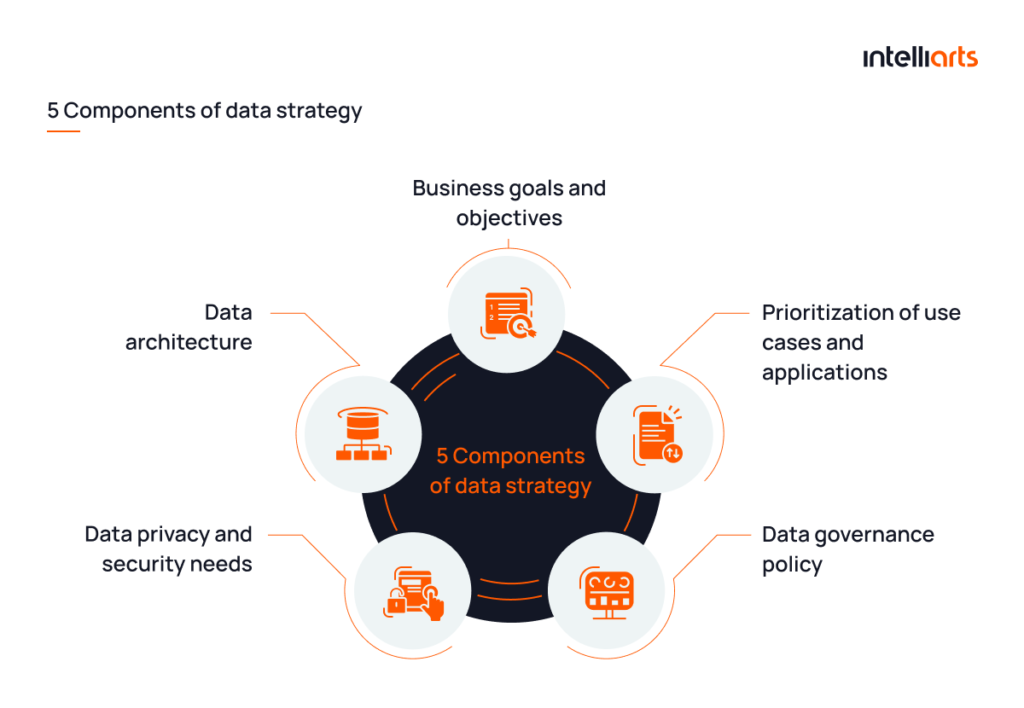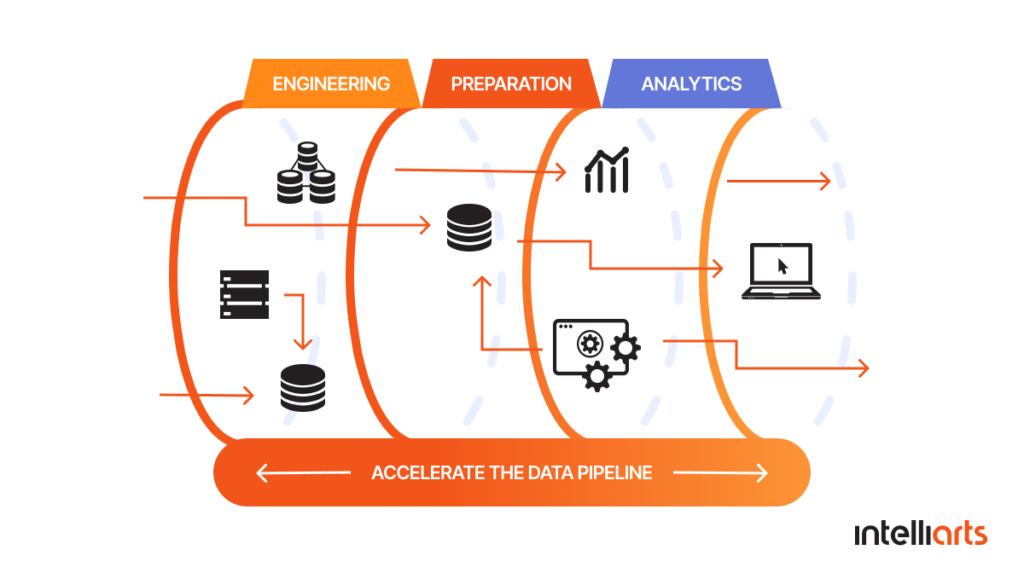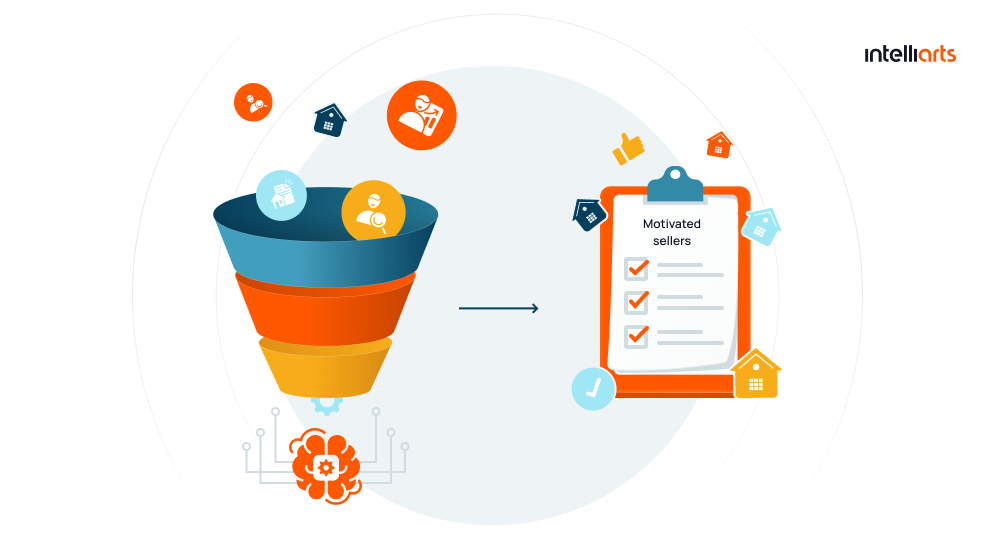Modern-day businesses generate vast amounts of data in their operational processes. However, the mere accumulation of data is insufficient for leveraging its true potential. For organizations aiming to gain a competitive edge building a well-defined big data strategy is not optional — it’s a business imperative.
As of 2022, the global big data industry market size amounted to $70 billion, and it’s forecasted to reach as much as $107 billion in 2027. Statistics show that the upward trend is quite solid, and more businesses are likely to adopt strategic big data in their digital environment.
From this post, you’ll discover key components and steps of a big data strategy and how to build a big data strategy. You’ll also get to know which specialists you’d better involve in building a proper big data strategy and what value big data consultancy can bring to your business.
Before building a big data strategy
A successful data strategy is what links business goals with technology solutions. You can get an insight into how the data is approached across different levels of data strategy from the infographics below.
It’s important to understand that modern approaches to data management stick to using AI-based methods instead of conventional ones where possible. For example, you may discover about intelligent forecasting and AI from another blog post by Intelliarts.
Let’s continue by reviewing the key aspects that should be considered prior to launching a project:
- Clear objectives. It’s essential to have a general understanding of what you aim to achieve with this project, including the specific problem you intend to solve. Preferably, you should also have a well-defined set of objectives to achieve throughout the course of the project — this can also serve as good criteria for a big data proposal.
- Budget. You should have an approximate budget estimation. The budget should be realistic, accounting for all potential costs involved, and should also have some room for contingencies.
- Time frame. The duration of the project should be planned with consideration of all variables, including resource availability, dependencies among tasks, and potential roadblocks. It’s also advisable to have a flexible time frame for the system transformation. Parallel changes should be avoided, as they could lead to unpredicted consequences.
- Existing documentation. It’s recommended to gather comprehensive documentation of the existing data and system. Such documentation will expedite the project’s initiation. Otherwise, the dev team will have to focus initial efforts on assessing the current situation before moving on to assessing the scope of corrective measures.
If you’re unsure where to start with your big data business strategy for a project, don’t hesitate to reach out to data scientists and data analysts from Intelliarts.
Now when you have an understanding of what essentials are good to have from the beginning, let’s proceed with learning the composition of a big data analytics strategy.
Key components of a big data strategy
Data science strategy is a plan for how an organization will collect, manage, and analyze data and derive value from it to meet specific business objectives. It should be created with the considerations of the following key components:
Business goals and objectives
Specific, measurable objectives provide a framework for what it’s intended to achieve with the data. Examples may include:
- Reducing operational costs
- Improving customer satisfaction
- Identifying new revenue streams
- Optimizing supply chain processes
- Discovering business opportunities
Setting clear goals will guide data collection, analysis, and utilization efforts.
Prioritization of use cases and applications
A big data business strategy can cover an extensive range of use cases and applications, such as:
- Predictive maintenance
- Sales forecasting
- Customer segmentation
- Social media monitoring
- Workforce analytics
It’s crucial to prioritize the listed to maximize ROI. Focus first on projects that yield quick wins or solve pressing issues. Subsequent phases can tackle more complex or long-term projects.
Data governance policy
A robust data governance policy ensures that data is consistent, trustworthy, and used responsibly. It outlines who has ownership of data, establishes data quality benchmarks, and details the procedures for data access and sharing.
A strong governance policy can minimize the risks of data silos, inconsistencies, and compliance issues, which can impede the successful execution of a big data strategy.
Data privacy and security needs
Data privacy and security are not optional but integral to a big data strategy. Complying with regulations like HIPAA, GDPR, or CCPA is just the starting point.
A comprehensive strategy will go beyond compliance to include data encryption, regular technical audits, and incident response plans. Failing to adequately address privacy and security concerns can result in financial penalties and reputational damage.
Data architecture
A well-designed data architecture is the backbone that supports data storage, integration, and retrieval. This involves choosing between data lakes, data warehouses, or hybrid solutions based on your specific needs.
Data architecture also concerns itself with data flow, scalability, and ensuring that the technology stack aligns with both current and future business requirements.
Since the big data strategy composition is clear, let’s find out how to build a data strategy for business.
7 Steps to build a big data strategy
A well-crafted strategy allows companies to effectively handle complex data sets and analytics at scale. Here you can find a roadmap for success in big data, which includes the steps how to develop a data strategy:
#1 Understand your business objectives
This step is about getting a clear idea of what is intended to be achieved with the strategy implementation. Auxiliary actions that can help you understand business objectives are the following:
- Conduct SWOT analysis
- Assess market needs and trends
- Identify Key Performance Indicators (KPIs)
- Outline short-term and long-term goals
- Prioritize objectives
- Align with stakeholders
- Conduct risk assessment
Outlining business objectives forms the backbone of your project, ensuring that all subsequent steps and decisions align with the overarching goals of the company.
#2 Initial assessment and scoping
Once business objectives are clearly defined, you should proceed with the initial assessment and scoping. The possible actions here are:
- Understand the current data landscape
- Identify technology and tools
- Establish the scope of a big data project
- Review regulatory and compliance environment
- Establish clear milestones
This step allows to obtain a realistic view of what’s already present and what’s needed to be done.
#3 Connect your data strategy with the business strategy
Integrating data strategy with the business strategy ensures that data initiatives contribute to the achievement of business goals. A well-defined strategy to deploy big data technology in a firm should involve reviewing business objectives, aligning data metrics with business KPIs, prioritizing data projects, and ensuring cross-departmental alignment. This integration also involves defining strategies for utilizing big data in corporate growth.
When the two strategies are well-aligned it allows for effective decision-making and a higher likelihood of success.
#4 Identify big data sources
Defining what sources of data will be involved in data strategy is the next step. To identify big data sources it’s necessary to consider data needs, internal and external data sources, and web and app analytics. Additionally, it’s advisable to decide on using real-time or batch data sources.
Should you need assistance with building a big data strategy, drop Intelliarts a line and let our qualified team make an impact.
#5 Create a data strategy roadmap
Next, you need to plan how to access, manage, and store the data. The guiding document that considers these matters is a data strategy roadmap, and it may include the following sections:
- Executive summary
- Situational analysis
- Strategic objectives
- Tactical plans
- Implementation timeline
- Monitoring and evaluation
- Conclusion and next steps
Data roadmap stretches over a specific time frame, such as one to five years.
#6 Set up monitoring and iteration
Mere obtaining suitable data from diverse sources is not enough to receive business value from a big data project. In the sixth step, you need to decide on how to analyze the data and what mechanisms to be involved to transform it into actionable insights. Consider making an effort to:
- Define analytical objectives
- Select appropriate analytical tools. The Intelliarts team recommends AWS SageMaker, Azure Machine Learning, H2O Driverless AI, IBM Watson Studio, DataBricks, Minitab, and Qlik AutoML.
- Develop analytical pipelines
- Implement quality checks
- Decide on how to interpret results
- Plan for regular review and update
This will help to get information, suitable for making intelligent, data-driven decisions.
#7 Plan how to make intelligent, data-driven decisions
A final part of a big data analytics strategy is figuring out how to transform insights into concrete predictions and decisions. Here it can be advised to:
- Define a decision framework
- Leverage predictive analytics and other ML technologies like descriptive analytics, data mining, business intelligence, etc.
- Select appropriate visualization tools. Here the Intelliarts team recommends Power BI, Tableau, Grafana, and Amazon QuickSight.
- Implement decision automation
You may be interested in learning more about big data value, data analytics, and machine learning in another of our blog posts.
Now, let’s get down to matters of hiring specialists to create and execute a big data business strategy and allocating time for such a project.
Hire data scientists, data analysts, and other data specialists to drive your strategy
Implementing a big data strategy requires the strong expertise and experience of a diverse team. The list of irreplaceable, in this project, specialists includes: Data engineers, data scientists, data analysts, big data and AI architects.
Additionally, the project may also require the involvement of cloud specialists, business analysts, data governance and compliance officers, domain experts, DevOps engineers, and project managers. Big data consultancy with a potential services provider can help with obtaining more accurate information.
As for project time estimations, it’s worth noting that small-scale projects take about three months from start to finish. Average to large-scale projects take six months or more to complete.
Some factors affecting the duration of data strategy development and execution project are:
- Team size
- Volume and complexity of data
- Potential data issues and technical debt
- Infrastructure specificities
- The need to comply with regulatory or other specific requirements
It can be recommended to consult with a specialized agency to get accurate estimations of the potential project’s time and costs.
Are you looking for a trusted provider of big data consulting services? Reach out to Intelliarts and let’s discuss cooperation opportunities!
Intelliarts experience with big data strategy
Here at Intelliarts, we have substantial experience helping our customers create a big data strategy and bring it to life. Our related big data strategy example includes the following:
DDMR data pipeline case study
The challenge was to help collect data on Firefox and optimize the efficiency of the big data collection process. Since the company was selling clickstream data, the success of its sales department largely depended on how the business handled big data.
The solution was a browser application and an end-to-end data pipeline which included data collection, storage, processing, and delivery. We grew from zero to operating clusters with 2000 cores and 3700 GB of RAM. During the cooperation, our customer multiplied its annual revenue and won a base of loyal customers.
Discover additional details about how Intelliarts built the big data pipeline from other our blog post.
Real estate case study
The challenge was to predict homeowners who are going to sell a house before the property is put up for sale. The company was tracking more than 1400 property and demographic data attributes and had a huge dataset with more than 60 million data records, and it was necessary to ensure the raw data was processed effectively.
The solution was the re-uploading of data to Amazon S3 data storage, completing data transformation, and establishing data processing with the help of AWS Glue. The model that can operate on the processed data can predict at least 70% of homeowners who are going to sell their houses. This result is a lot above the average in the industry.
Final take
A big data strategy is a comprehensive plan for a business to approach its data. It should encompass business goals and objectives, data architecture, use cases, etc. Ideally, a big data strategy should be created and executed by specialized scientists and engineers, and such a project may take 3-6 months or more to complete. Also, incorporating business development strategies for big data can enhance the scalability and impact of your initiatives. Staying updated with emerging big data trends is crucial for ensuring that your strategy is future-proof and leverages the latest advancements in analytics, AI, and machine learning.
Should you intend to create a big data enterprise-level strategy or a smaller-scale strategy, consider Intelliarts as your trusted development partner. With over 24 years on the market and a team of big data experts, we can help bring your project to success.
FAQ
1. Why is a big data strategy important?
Big data strategy empowers businesses to manage their data effectively and generate data-driven insights. Such outcomes allow to make informed decisions, gain competitive advantage, optimize operations, and enhance customer experiences.
2. What are the challenges of building a data strategy?
Challenges and limitations to creating a big data strategy include resource limitations, data quality issues, achieving alignment between data initiatives and business goals, ensuring compliance, data security, etc.
3. How can organizations identify big data sources?
Ways to identify big data sources for organizations are auditing existing databases, examining external data streams like social media, and collaborating with domain experts or data science agency to pinpoint relevant data. These are also foundational ways to implement big data strategies effectively.













